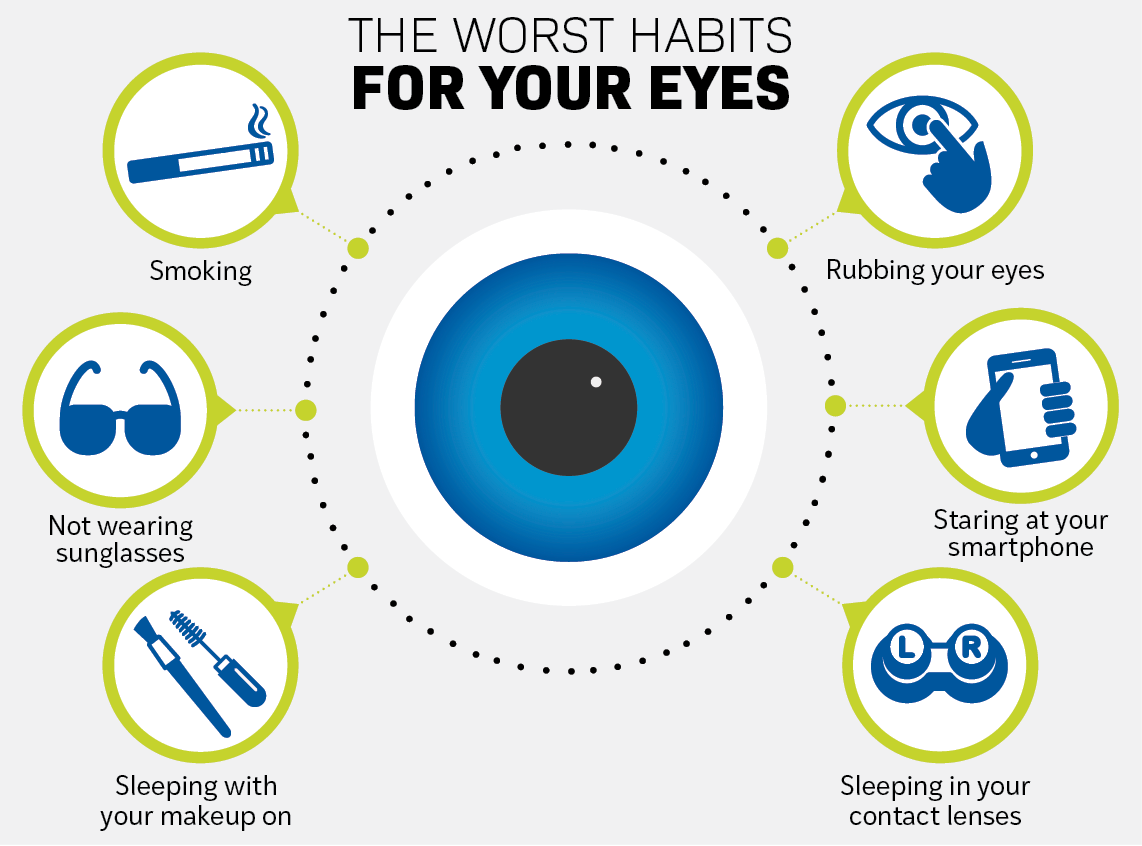6 daily habits destroying your eyes
These habits wreak havoc on your vision

An annual eye exam with an Optometrist (OD) is a must-do for detecting the early signs of vision loss. In addition to keeping track of visual changes, ODs sound the alarm on vision’s biggest foes: glaucoma, cataracts, age-related macular degeneration (AMD), and diabetes, to name a few. Conditions like these can cause irreparable damage before vision even begins to fade.
Aside from keeping up with regular eye examinations, it is also important to recognize the habits that most affect vision.
These 6 daily habits are destroying your eyes:1
1. Smoking
Not only are cigarettes irritating to eyes, but they can also make individuals more prone to developing age-related macular degeneration (AMD), which can blur central vision.1 Studies show smoking increases the chances of getting late AMD by almost four-fold.2,3 Additionally, people who smoke have a higher percentage of developing AMD five years earlier than those who never smoke.2
Related: Quitting smoking may lower long-term cataract risk
2. Staring at screens
Digital device use is on the rise as people spend more time at home. Reports from Nielsen indicate media consumption increased 60% to 13 hours a day in March 2020, due to COVID-19 and home confinement. That compares to between 7 and 10 hours per day before the COVID-19 pandemic started, with the increase in screen time likely contributing to more exposure to blue light.4
Staring at screens can affect natural sleep patterns when light from a digital device signals to the brain that it is daytime at night.1 Screens may also worsen dry eye symptoms as blinking frequency and blink completeness reduce during extended periods of digital device use.1
There is evidence that digital device use may lead to eye strain, when eyes work harder than usual to focus on screens.1 According to the American Optometric Association, the most common symptoms associated with digital eye strain (DES) are eyestrain, headaches, blurred vision, dry eyes and pain in the neck and shoulders.5
Related: 5 tips to help block blue light in an increasingly remote world
3. Failing to wear sunglasses
Most people are aware of the dangers sun exposure can have on skin. But many forget ultraviolet (UV) radiation from the sun’s damaging impact on the tissues of the eye, including the lens and cornea.1 It can cause cataracts, AMD, and even cancer.6 Wearing sunglasses is a simple way to protect yourself from the harmful effects of ultraviolet radiation. Aside from blocking UV rays, sunglasses can also help prevent the formation of cataracts.1
Related: Sunwear and the science of light
4. Sleeping with contact lenses in
The safety profile of contact lenses depends on how they are worn. They are not designed to be slept in and when this happens, bacteria can get trapped between the lens and the cornea. When continuously used incorrectly, serious eye infection, resulting in permanent ocular damage can develop.
A report by the Centers for Disease Control (CDC) noted that around one in three contact lens users admit to sleeping or napping in them.7 This increases their risk of getting a contact lens-related infection by six to eight times.
Related: Ensuring patient success with contact lenses
5. Rubbing your eyes
Even though it is not dangerous to occasionally rub your eyes, doing so repetitively and aggressively could damage the cornea, the delicate surface of the eye. One particular condition known as keratoconus occurs when the tissue that covers the front surface of the eye begins to thin and bulge outward into a cone shape. Blurry and distorted vision may follow. Simply put, it’s best to avoid too much eye rubbing.
Related: 5 myths and misunderstandings about cross-linking and keratoconus
6. Falling asleep with makeup on
Occasionally falling asleep with makeup on won’t hurt your eyes. Doing so habitually, though, can exacerbate dry eye disease and increase your chance of infection and styes.1,8
References
1. Goad K. The Worst Habits for Your Eyes. AARP. December 13, 2021. Accessed March 4, 2022. https://www.aarp.org/health/conditions-treatments/info-2021/bad-habits-for-eyes.html
2. Tan JSL, Mitchell P, Kifley A, Flood V, Smith W, Wang JJ. Smoking and the Long-term Incidence of Age-Related Macular Degeneration: The Blue Mountains Eye Study. Arch Ophthalmol. 2007;125(8):1089–1095. doi:10.1001/archopht.125.8.1089
3. Thornton J, Edwards R, Mitchell P, Harrison RA, Buchan I, Kelly SP. Smoking and age-related macular degeneration: a review of association. Eye (Lond). 2005 Sep;19(9):935-44. doi: 10.1038/sj.eye.6701978. PMID: 16151432.
4. Edmonds S. 5 tips to help block blue light in an increasingly remote world. Optometry Times. Accessed March 4, 2022. https://www.optometrytimes.com/view/5-tips-to-help-block-blue-light-in-an-increasingly-remote-world
5. Computer vision syndrome. American Optometric Association. 2017. Accessed March 4, 2022. https://www.aoa.org/patients-and-public/caring-for-your-vision/protecting-your-vision/computer-vision-syndrome?sso=y
6. Roberts JE. Ultraviolet radiation as a risk factor for cataract and macular degeneration. Eye Contact Lens. 2011 Jul;37(4):246-9. doi: 10.1097/ICL.0b013e31821cbcc9. PMID: 21617534.
7. Cope JR, Konne NM, Jacobs DS, et al. Corneal Infections Associated with Sleeping in Contact Lenses - Six Cases, United States, 2016-2018. MMWR Morb Mortal Wkly Rep. 2018;67(32):877-881. Published 2018 Aug 17. doi:10.15585/mmwr.mm6732a2
8. Yazdani M, Elgstøen KBP, Utheim TP. Eye Make-up Products and Dry Eye Disease: A Mini Review. Curr Eye Res. 2022 Jan;47(1):1-11. doi: 10.1080/02713683.2021.1966476. Epub 2021 Sep 19. PMID: 34365876.
Newsletter
Want more insights like this? Subscribe to Optometry Times and get clinical pearls and practice tips delivered straight to your inbox.